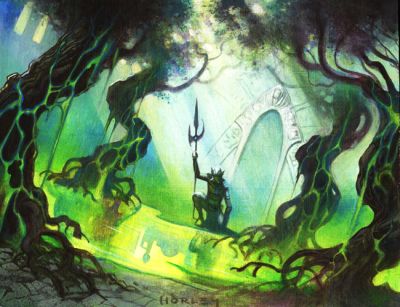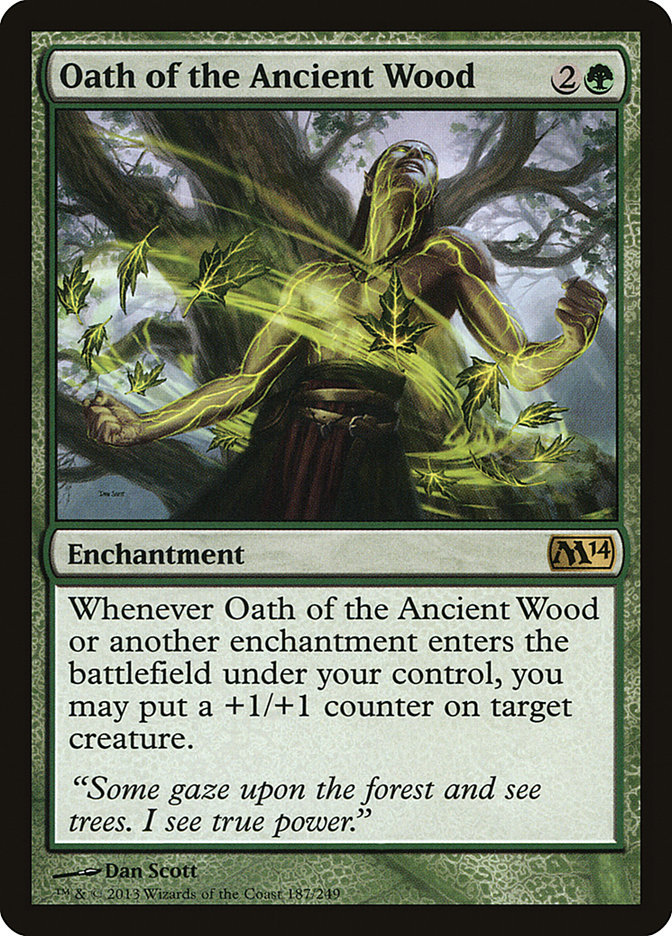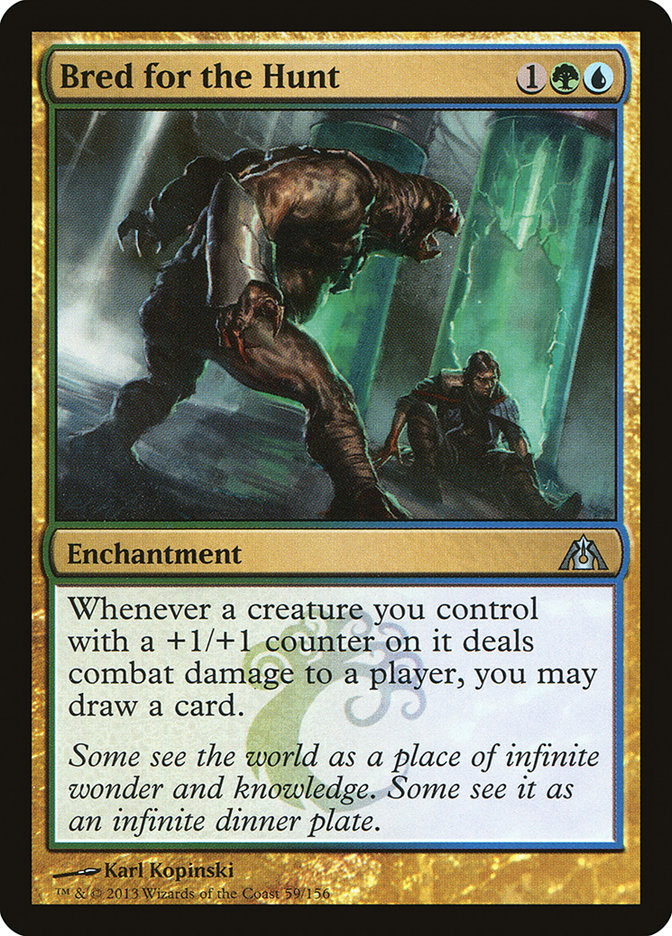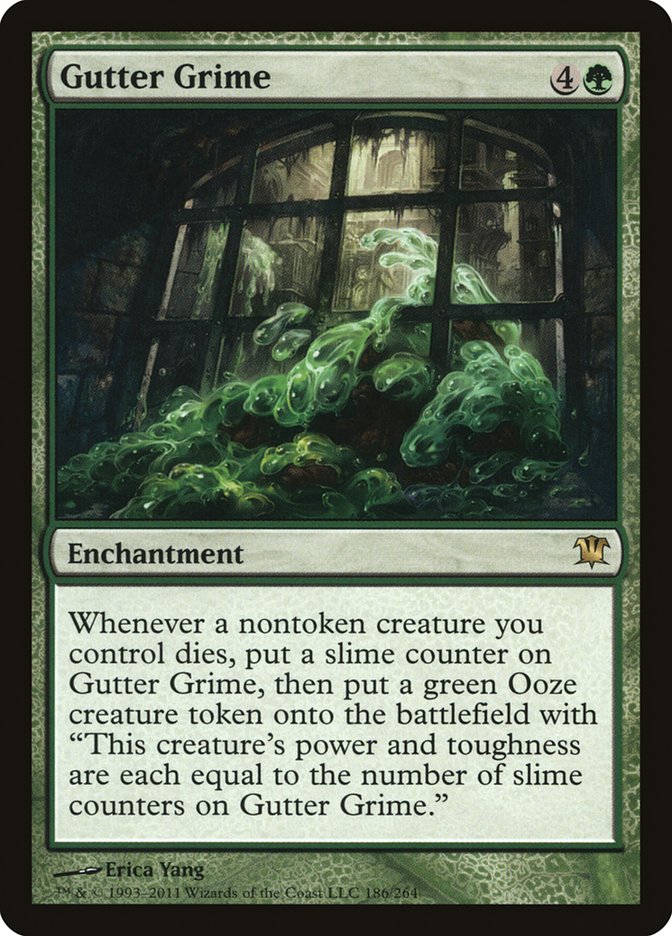Every Magic player wants to grow. Whether you sling cards with friends and family at the kitchen table or you’re number crunching a deck for an upcoming Open Series, PTQ, or Grand Prix, everyone who plays the beautiful game has a desire to make better plays, build stronger decks, and win more matches. Blame whatever you want; competitive streaks, peer pressure, and personal satisfaction all drive us to become better players. The fact that you’re here reading this article should be proof enough of your passion for Magic.
Recently, our return to Ravnica brought the guild theme back into the spotlight. Players proudly wear their guild’s colors and tell their neighbors which guild they relate with the most. I’m Gruul, the passionate, naturalistic shamans of the wild, and you might be a member of the calculating, tactical Azorius Senate or the hedonistic Cult of Rakdos. Despite our personal preferences, I would argue that every Magic player, no matter which guild we pick and no matter what a survey tells us, has a bit of Simic in them.

Manipulation of matter and applied learning both characterize the Combine, and that’s what we all do as Magic players. We experiment, creating control groups to test the validity of a card that when placed in a vacuum looks appealing. We run our data (even something as subjective as “this card rocked” or “this card blew chunks”) and make improvements based on our analysis. It sounds a bit highfaluting, but I bet you do it nonetheless.
Simic colors provide nearly unmatched depth; green’s mighty creatures and utility spells are more fleshed out than ever in my opinion, and blue always has creative ways to deal with persistent problems and on-the-stack issues. I love brewing with them, and there aren’t many colors combinations that could produce decks as different as the two I’m bringing you today. The first is based on a brand-new card fresh from packs of M14, while the second deck highlights two cards long lost to the mediocrity of Innistrad block’s bulk rare-dom.
Let’s look at our first inspiration card.
M14 provided fodder for Theros and its predicted enchantment-heavy nature, but I wanted to dive in with this card as soon as possible. The Oath is a subtle card. It looks pretty weak at first but rocks in multiples, and that incremental advantage of a +1/+1 counter for no mana while you just play enchantments is surprisingly effective at swelling a puny critter to formidable proportions. It wasn’t long before I found its perfect match: Bred for the Hunt.
Another enchantment that cares about +1/+1 counters . . . how do I put the pieces together for an aggro deck that uses this stuff?
My first build, too laughable to share here, was a disaster. Chock full of mana dorks, the deck was utterly ineffective at doing anything but building up one big guy to get Doom Bladed, Azorius Charmed, or Searing Speared a moment later. It couldn’t land a hit that was worth much and was terribly inconsistent. I scrapped the deck and redrew the plan. Hexproof seemed like a necessity for a deck like this, and enchantments also prefer hexproof creatures. The creature base was my main problem, so I retooled it and tried again. Here’s where I landed.
(Pronounced “hex-goof.”)
Creatures (17)
Lands (19)
Spells (24)
- 4 Rancor
- 4 Curiosity
- 4 Spectral Flight
- 3 Abundant Growth
- 4 Hands of Binding
- 1 Bred for the Hunt
- 4 Oath of the Ancient Wood
Sideboard

Creatures
Ten Hexproof creatures and seven undying creatures eventually replaced all the mana dorks and wussy spells. Starting with the untargetables, Gladecover Scout is a necessary piece to this deck’s equation. Gladecover Scout saw play just recently at the top tournament table in the world. If Reid Duke thinks it’s good enough, why shouldn’t we? Getting a turn 2 attack in with at least one enchantment will swing the dial in your favor. Every Aura you draw improves the Scout, and it’s a surprisingly relevant play throughout the game, giving you another body to suit up with enchantments or +1/+1 counters.
Invisible Stalker, whose copies are limited to three for color and “bad in multiples” reasons, is a familiar face on the hexproof scene. The safest target to pump, the Stalker will never stop hitting your opponent until they’re dead; decks like this need that kind of reliability and consistency. Witchstalker, the middle child of the new hoser cycle, is a very large, cheap hexproof body. The +1/+1 counter clause is nice, but I don’t think it’ll be too relevant most of the time. It’s just a cheaper Primal Huntbeast, and that’s all we need.
For our purposes, the undying creatures serve three purposes. First, they come with built-in protection that performs a similar function to hexproof, preventing you from losing all of your investment. They survive sweeper effects, which hexproof creatures don’t, and normal removal doesn’t faze them. They even block well and come back ready for battle a second time. Second, they come with a +1/+1 counter built in for Bred for the Hunt. Bear in mind that you shouldn’t use Oath on an undying creature until it has come back; the counter from Oath will turn off your Wolf or Geist’s self-resurrection.
Finally, cheap undying creatures provide a buffer against sacrifice outlets, a considerable danger to Hexproof decks. Resolving a Gladecover Scout followed by two Wolfs will pad the Elf on either side of a Liliana of the Veil, Devour Flesh, or Away. This is more niche, but decks that prepare to fight Hexproof decks often pack such an answer. Young Wolf is here solely for being cheap and reusable, but Strangleroot Geist provides another important piece to every aggro puzzle: haste. Haste makes people nervous, and putting it on your side can keep you on the offensive more often than not. Every deck that wants Strangleroot Geist probably wants twenty of them, so I played a full set of them.
Enchantments
Every spell, even Hands of Binding, is an enchantment in this deck. We’ll start there. Hands of Binding is a blue aggressor’s dream, disabling their attacker/blocker while pushing yours through. The speed of this deck lets you take advantage of the first hit and every hit thereafter, locking up your opponent’s offense while you pummel away. On Invisible Stalker, you are guaranteed to pin (“pin” being my shorthand way of describing what this and similar spells do) one creature a turn, and every copy you draw is all the better, letting you sneak in less evasive creatures for multiplied effect. I am a huge fan of this card and have tried to make it work at every opportunity. It’s the only playable cipher spell, so I gotta try.
Playsets each of Rancor, Spectral Flight, Curiosity, and Oath of the Ancient Wood make up the power ups. Rancor is naturally awesome, being cheap, recastable, and power pumping. Spectral Flight is close behind, offering evasion and a power boost on the cheap. Curiosity is fine on a turn 1 creature, but it can be just an advantage engine on an evasive or trampling creature. Hitting once will return your card investment, and being so cheap lets you easily trigger Oath of the Ancient Wood multiple times per turn.
The Oath is a key part of the deck’s win condition. You’ll notice that save Witchstalker none of my creatures are too strong. Every enchantment I cast makes them stronger and puts me closer to winning; your opponent will have to do the math each time they think about letting one of your hexproof creatures through. Can I take a hit if your one-mana Rancor adds three power to your Gladecover Scout? Two could add six power. Yeesh, I guess I’ll scoop. I know it’s a bit of a nonbo with the undying creatures, but you can just choose not to pump them.
The other enchantments are fairly utilitarian. Abundant Growth is cheap, triggers the Oath, and provides necessary fixing for an anemic mana base. I pared down Bred for the Hunt to a single copy, allowing Curiosity to do a cheaper, less tricky job. One copy is still fine, as there will be occasions where they will be up some life and your undying dudes will hit them and give you a Tidings. It is hanging on by its fingertips, but I still feel ok including one for now.
Lands
The land base is very small and as simple as possible. This deck generally wants green mana, having only a few cards that need blue mana. There isn’t room for any colorless land, nor is there really a benefit to including one. I originally played Mutavault in the mana dork version but found that it color screwed me more often than not. Nineteen lands is not a lot by today’s standards; even Blitz-style decks generally play 22 or more. However, this deck is full of cheap drops and early draw (Curiosity and Abundant Growth) to get you in there. In practice, the deck also mulligans very well, so don’t be afraid to toss a hand back if it looks shady. I very rarely found myself short on mana frankly; I’m not sure how, but there it is.
Sideboard
In the board, we’ve got some Oozes and some bizarre tricks. First off, Scavenging Ooze has effectively shut down Junk Reanimator in most shops and tournaments that I’ve seen. If it’s still a problem, use it here; the +1/+1 counter synergy still exists, and it’s a perfectly fine Ooze all by itself. If Junk Reanimator is absent from your local metagame and/or you don’t have the budget for a playset, I recommend Spire Tracer instead. Spire Tracer is a better version of Gladecover Scout when evasion is more important than removal resistance, like against 30+ creature decks.
Spell Rupture sides in one for one over Hands of Binding when pinning creatures will happen infrequently or will be irrelevant. Hexproof creatures tend to resist instant removal, so this can be Mana Leak or better as the game progresses, scaling to fit your needs. Predator Ooze sides in on a one-for-one basis for Witchstalker as well. Witchstalker isn’t as good against Supreme Verdict no matter how big it gets, and Predator Ooze is much better against damage and “destroy” effects. It still has a +1/+1 counter theme to make everybody happy, but it’s a very safe place to put any enchantments. There may be situations where you should play both the Ooze and the Witchstalker, so don’t rule that out.
Triumph of Cruelty is good against a swarm deck and/or a control deck where your Rancored Invisible Stalker will be the biggest thing in town. Against many aggro decks or midrange decks, this condition may be a challenge to meet, which is why it rests here.
Finally, a single Fog can make or break a game; with all the draw and cheap spells this deck manages, it’s easier to find one copy of Fog, and if they tap down for an alpha strike, there’s no better feeling than Fogging. The deck can pan out to be a race, and depending on a Hellrider or Falkenrath Aristocrat, you might lose. Maybe it’s wrong, but I think it has a place in a back-and-forth matchup.
In playtesting, HexGUf performed well and with astonishing consistency. Despite a low land count and not a ton of things to do on one, this deck often came out swinging with Rancor and Curiosity ready. Hitting land drops on time was directly proportional to my deck’s win percentage, so again don’t be afraid to mulligan. In general, this deck did very well against Naya and Mono-Red, but it struggled with The Aristocrats, Jund Midrange (whose card quality is just a bunch better), U/W/R Flash, and real (Bant) Hexproof.
It was definitely best against aggro obviously, but in every match I was so excited to play. This deck is addictive; you will want to play fourteen-game matches. It rewards good choices and calculation and is a nice, fun aggro deck that could run away with an FNM or even place well in a Magic Online Daily. Reanimator decks were nowhere to be found, so Spire Tracer is probably just a better choice over Scavenging Ooze. I highly recommend this inexpensive brew!

I took a lot of time on the first deck, but I’m pretty excited about this one too!
In contrast to the first deck’s upbeat, rave-like tempo, this deck, despite having more creature than list number one, is a slow jam. As a second edition of a deck I covered before coming to StarCityGames.com on a weekly basis, this deck takes a known casual shell and adds a bit of goo to the mix.
Creatures (27)
- 3 Clone
- 2 Silklash Spider
- 4 Wall of Frost
- 3 Tree of Redemption
- 3 Ludevic's Test Subject
- 4 Axebane Guardian
- 4 Doorkeeper
- 4 Murmuring Phantasm
Planeswalkers (3)
Lands (25)
Spells (5)
Sideboard

Creatures
This deck is full of tall, immovable walls; 27 of them to be precise. Starting on the cheap, Murmuring Phantasm’s extra point of toughness does a lot for it. As a 0/5, Mizzium Mortars does not kill it, a Rancored 2/2 doesn’t overrun it, and it stonewalls a Loxodon Smiter. There is nothing flashy about this terrifying wall, but it is the best defender for the money. Doorkeeper is included for redundancy, though it’s possible to eventually mill someone out with multiples of them. Ludevic’s Test Subject was the star of the deck I featured last year, and it offers an alternative win condition in the form of a monstrous rumbler.
Axebane Guardian acts as little more than ramp to the noncreature spells that we’ll cover in a minute; it doesn’t block very well (stopping little more than a Burning-Tree Emissary) and thus is effectively an Elvish Archdruid that taps for any color. Wall of Frost, a crucial player reintroduced through M14, actually puts you ahead in the blocking game. There’s little stopping an opponent from just crashing against the gates every turn if your defenders have no power, but Wall of Frost is a large dissuader of attacks, removing your opponent’s best attacker from the equation turn after turn.
Tree of Redemption despite having a huge, uh, trunk provides lots of synergy for the spells to come. The ability to roll your opponent’s offensive damage back a couple turns is awesome. Clone is here as a bit of a test; occasionally, you might copy a Doorkeeper, Ludevic’s Abomination or such, but you might also imitate your opponent’s Thragtusk, Boros Reckoner, or Lifebane Zombie. Whatever Clone copies, you’ll be getting a deal. Silklash Spider, originally a sideboard player, has a huge enough rump and enough power to dissuade all but the ablest attackers. As always, it rakes Lingering Souls tokens, Restoration Angels, and heartily defends against Thundermaw Hellkite. Love ’em.
Spells
This is where the uniqueness of the deck shines:
Travis Woo had some memorable moments with this card last year in his Green Summer deck, and I’m going to try to bring it back in the limelight. While your opponent is pummeling away at the wall, if a wall dies you can replace it with a humble Ooze. Get wrathed, on the other hand, and you spawn a massive Ooze army from the ashes. It’s a great insurance policy as well as an intriguing win condition. Feed the Pack similarly takes your best defender, eats it, and spits out up to a baker’s dozen of Wolves! Even better, flip your Tree’s toughness to a clean twenty and you can get a score of them. Even a sturdy army will be hard pressed to stop a vicious pack of Wolves every turn.
Three planeswalkers augment the wall suite; Jace, Architect of Thought helps your blockers live through an assault as well as dig deeper to find one of your game-changing enchantments. Tamiyo is also a great tool. She can pin your best blocker, which leaves your opponent with two choices: swing with the team, get blocked all day and let you draw a bunch of cards off Tamiyo, or just not attack. Either way, your opponent will be in a bind, and you’ll have more time to assemble the Wolves and Oozes you need. As a bit of a laugh, Biomass Mutation can either dissolve your team into Oozes at instant speed when X = 0 or give your team some power to thwart an alpha strike; Axebane Guardian should give you plenty of mana to give your walls some real teeth.
The lands are pretty straightforward, so let’s talk about the sideboard. Front and center we find two sets of defenders not found in the maindeck. Fog Bank is susceptible to both Silklash Spider and burn spells, making it less of a maindeck choice than I’d like. It’s not good at stopping trample either. There will be times where Fog Bank will be perfect, and it can blow in when the time is right. Haunted Guardian is a wall with some bite; if your opponent’s deck is choc-a-bloc with X/2s, Haunted Guardian can hold them at bay all by itself. In multiples, the Guardians can eat some pretty impressive things.
Next, Sheltering Word protects an essential creature while giving you an immense amount of life. Target Tree of Redemption for maximum effect! As the deck is weak to burn and over-the-top cards, this life-gain effect is just as relevant as the protection effect. Similarly, Pithing Needle deals with things this one-note deck might not be able to combat otherwise. Finally, Acidic Slime comes in for problem NCPs and can replace the Spider easily for when the matches call for it.
Unlike the Hexproof deck, this one remains relatively untested; the previous version of this deck, which looked much different, played out well, finishing 2-1-1 the night I played it at FNM a year or so ago. I think this version is a little more direct and might be better against an aggro-heavy field. Both this deck and the previous deck are fairly inexpensive given a few key parts, so I hope you’ll give one a go!
Challenge Update
Last week I introduced a new, more involved Untapped challenge: construct a Commander/EDH deck based around a commander that costs less than $.99. Here’s a recap if you need it:
- Format: Commander
- For this challenge, you will first select a commander around which you will build your deck. The commander you choose must cost $0.99 or less for a NM/M copy based on StarCityGames.com pricing. Any set or version of the chosen commander that fits that criterion is acceptable.
- Using normal Commander deckbuilding rules (99 cards + your commander, no duplicates except basic lands), you will construct a Commander deck in which your chosen commander plays a central part. I’m not looking for decks that use a commander just for its color identity; instead, I want to see a commander that is integral or synergetic in regards to the deck’s desired function.
- The cards you put into the deck should directly support the commander. Naturally, staple utility spells are acceptable (i.e., Rhystic Study, Sensei’s Divining Top, Wrath of God); just make sure there are plenty of support cards too.
- Card synergy is more important than card knowledge. In other words, it doesn’t matter if you don’t know that Sol Ring is a better version of Ur-Golem’s Eye; what matters is that your strategy is clear, unique, and well supported. When explaining your deck, there’s no need to go into exhaustive detail either. I can usually figure it out and generally enjoy the prospect of doing so.
- No sideboard is required.
- As with my Standard challenges, I will be looking for four things: originality, adherence to the theme, synergy, and playability.
Also, the chosen deck will win a signed (by me) foil copy of their chosen commander as a commemoration of your victory! I’ll probably select two runners-up just to share the decks. I’ve already gotten lots of submission, many of which appear to be decks you’ve been playing and tweaking for years, which is great! The more experience you bring to your decklist, the more we all benefit! I’ve also gotten several really off-the-wall ones, which is also great; it means you know your audience!
Your submissions are due August 17, 2013 by 11:59 PM PDT. I’ll ask the winner for their mailing address by email, and the prize should arrive by the end of August. You can send your submissions to [email protected]. Remember, you can submit a deck multiple times, but bear in mind I will only take the most recent submission as your submission for the challenge.
Because I don’t have a challenge deck to share this week, I’ll give you an update to a deck I’ve been playing on Magic Online for the last couple months that got some major upgrades with M14.
Creatures (16)
Lands (23)
Spells (21)
- 2 Dissipate
- 1 Opportunity
- 3 Unsummon
- 3 Think Twice
- 3 Essence Scatter
- 4 Cackling Counterpart
- 1 Blustersquall
- 4 Hands of Binding
Sideboard

This is the exact version I’ve been playing on Magic Online for the last week or so, and I just can’t stop. It has good matchups all over the place and can answer most strategies with ease. Also, let me just tell you something. Tidebinder Mage is the best thing that ever happened to this deck; every Fish deck in Eternal formats should play this card. Even in our current format this will almost always have targets in every deck you play. Playing this to pin a mana dork and then copying it with Cackling Counterpart to pin their next play just feels dirty. This deck has a problem with Mono-Red Aggro, but that’s it. It’s dirt cheap (the Mutavaults are the most expensive thing at about 6.5 tickets each,) but I am so pleased with this deck in practice. I’ll be rolling it for the foreseeable pre-Theros future.
Whew, that was a lot today! I hope you’ll join me next week when I unveil the winner of our Untapped challenge and the runners-up as well as my own submission. Until then, don’t forget to untap your Breeding Pools!
– Matt
CaptainShapiro on Magic Online



